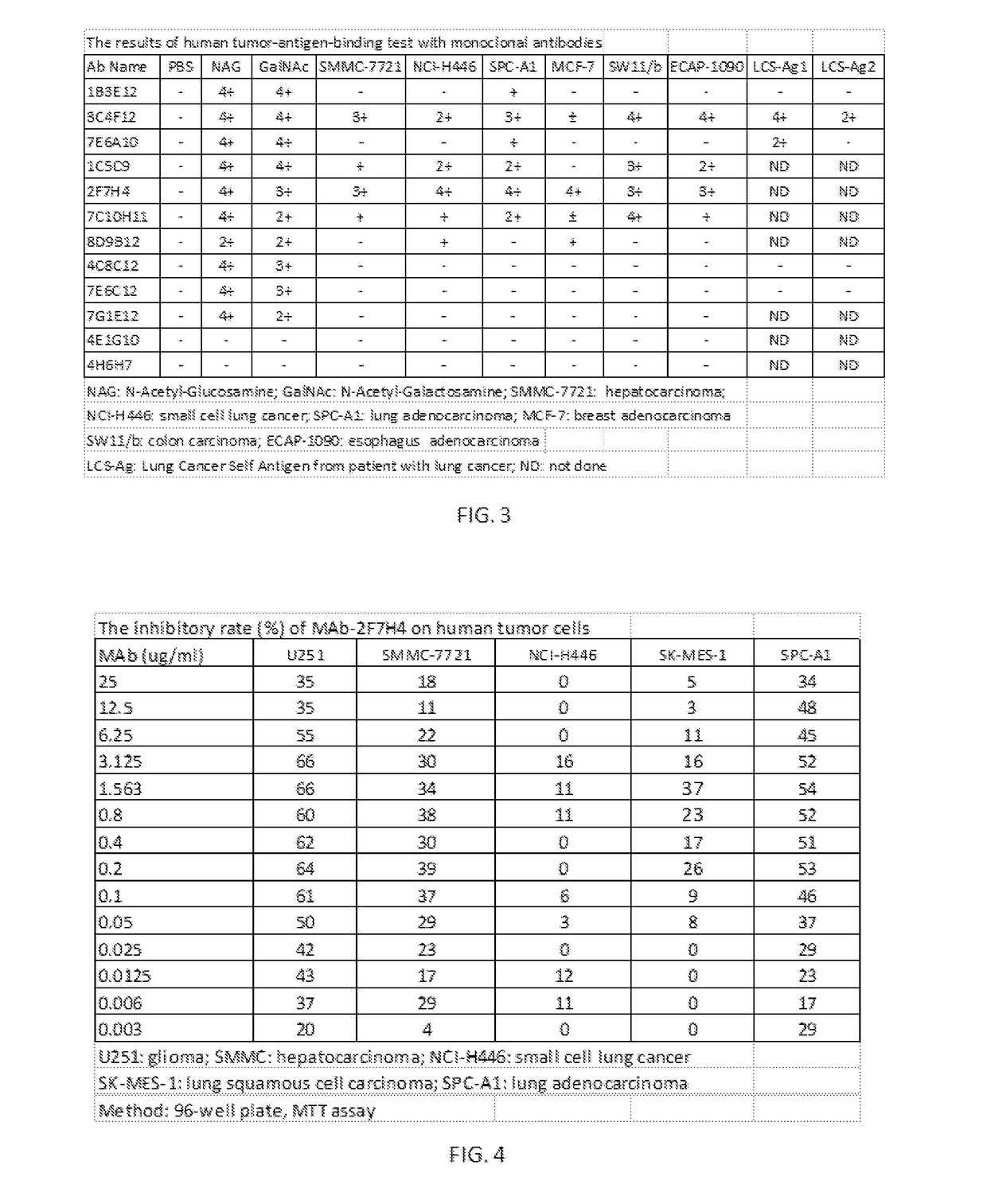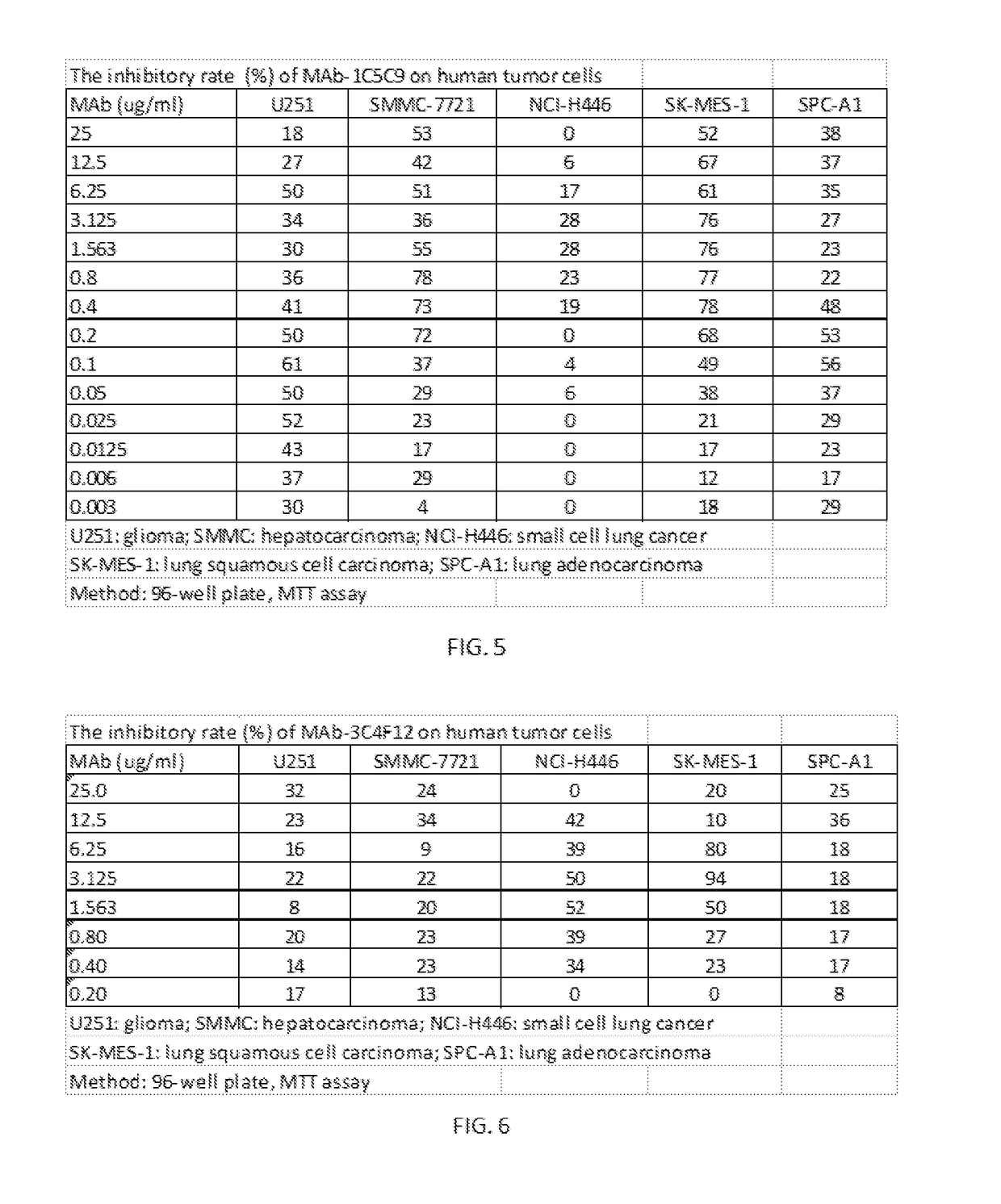Saccharide-based biomarkers and therapeutics
a biomarker and a technology of saccharide, applied in the field of saccharide-based biomarkers and therapeutics, can solve the problems of difficult differentiation of cancerous cells from normal cells within a patient, high diversity, and difficulty in the immune system of the body in identifying and eliminating cancerous cells, so as to reduce the growth rate of several diverse types
- Summary
- Abstract
- Description
- Claims
- Application Information
AI Technical Summary
Benefits of technology
Problems solved by technology
Method used
Image
Examples
example 1
n of N-Acetylglucosamine and N-Acetyl-Galactosamine on Cancer Cells
[0184]The identification of biomarkers that are preferentially expressed by cancer cells, rather than normal human cells, may allow for the design of new assays and therapeutic approaches to aid in the diagnosis, treatment, and / or prevention of cancer. To meet this demand, described herein are monoclonal antibodies that bind to N-acetylglucosamine and N-acetyl-galactosamine. These results are based in part on the surprising discovery that N-acetylglucosamine and N-acetyl-galactosamine are expressed on the surface of many disparate cancer cells but show little to no expression in normal human tissues. As a result, monoclonal antibodies that bind to N-acetylglucosamine and N-acetyl-galactosamine and inhibit the growth of cancer cells may find great potential use in the diagnosis, treatment, and / or prevention of cancer.
[0185]Materials and Methods
[0186]Binding of wheat germ agglutinin (WGA) to human healthy ...
example 2
n of Monoclonal Antibodies Recognizing N-Acetylglucosamine and N-Acetyl-Galactosamine
[0198]The above results demonstrate the unexpected findings that N-acetylglucosamine and / or N-acetyl-galactosamine are preferentially expressed in a range of human cancerous tissues and cell lines but show little or no expression in most normal human tissues. Therefore, methods for diagnosis of cancers may be developed by detecting the presence of N-acetylglucosamine and / or N-acetyl-galactosamine, using molecules capable of binding to N-acetylglucosamine and / or N-acetyl-galactosamine in a biological sample of a subject suspected of having a cancer. In addition, agents that bind and inhibit the growth of a cancerous cell expressing N-acetylglucosamine and / or N-acetyl-galactosamine, or agents that inhibit pathways relating to expression of N-acetylglucosamine and / or N-acetyl-galactosamine may serve as potentially useful in the treatment and / or prevention of cancers. To meet this goal, described herein...
example 3
l Antibodies Recognizing N-Acetyl-Glucosamine and N-Acetyl Galactosamine Inhibit Cancer Cell Growth In Vitro
[0202]The previous Example demonstrates the generation of monoclonal antibodies that recognize N-acetylglucosamine and / or N-acetyl-galactosamine. These antibodies were subsequently tested for their ability to block the growth of various cancer cell lines in vitro.
[0203]To test selected antibodies, the MTT growth assay described above was used to examine how treatment with each antibody affected the proliferation (i.e., growth rate) of human cancer cell lines U251 (glioma), SMMC-7721 (hepatocarcinoma), NCI-H466 (small cell lung cancer), SK-MES-1 (lung squamous cell carcinoma), SPC-A1 (lung adenocarcinoma), MCF-7 (human breast cancer), SKOV-3 (human ovary cancer), and Hela (cervical cancer). In each experiment, antibodies were tested at a range of concentrations (i.e., doses).
[0204]FIG. 4 demonstrates the effect of monoclonal antibody 2F7H4 on the proliferation of various human ...
PUM
| Property | Measurement | Unit |
|---|---|---|
| concentration | aaaaa | aaaaa |
| concentration | aaaaa | aaaaa |
| time | aaaaa | aaaaa |
Abstract
Description
Claims
Application Information
 Login to View More
Login to View More - R&D
- Intellectual Property
- Life Sciences
- Materials
- Tech Scout
- Unparalleled Data Quality
- Higher Quality Content
- 60% Fewer Hallucinations
Browse by: Latest US Patents, China's latest patents, Technical Efficacy Thesaurus, Application Domain, Technology Topic, Popular Technical Reports.
© 2025 PatSnap. All rights reserved.Legal|Privacy policy|Modern Slavery Act Transparency Statement|Sitemap|About US| Contact US: help@patsnap.com



